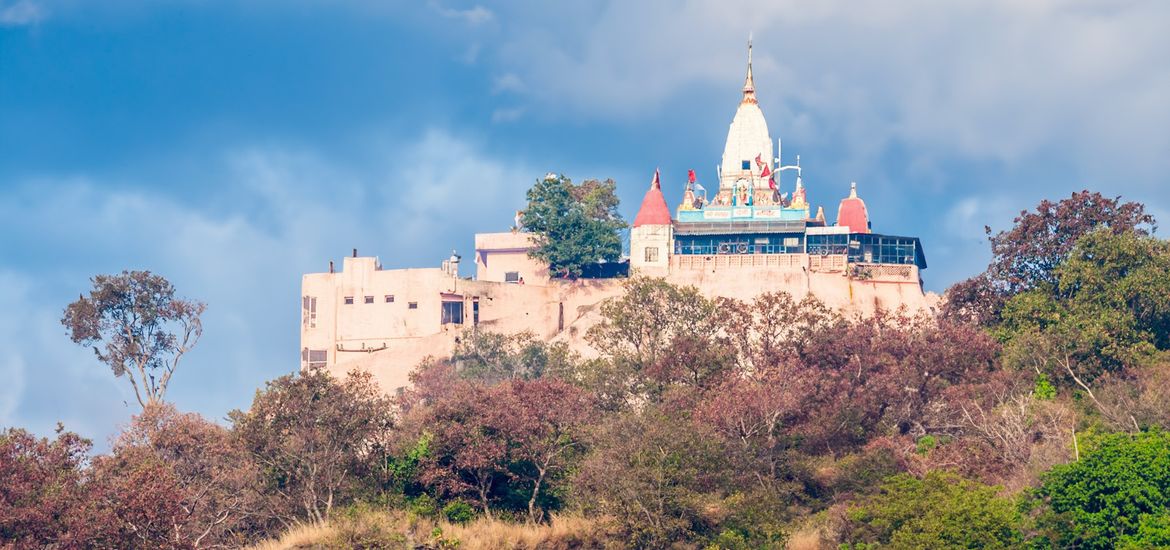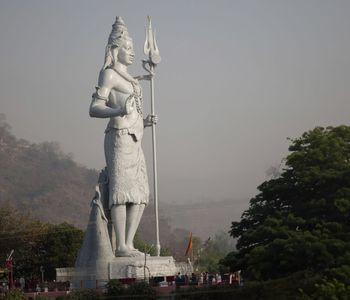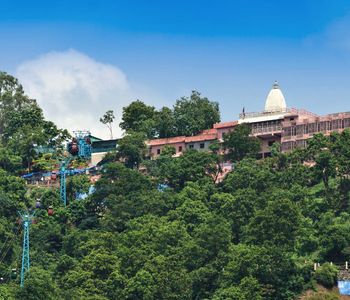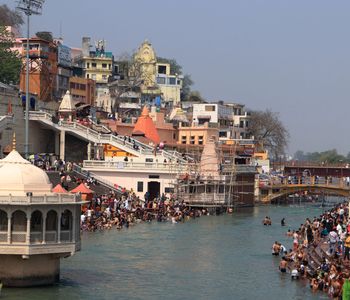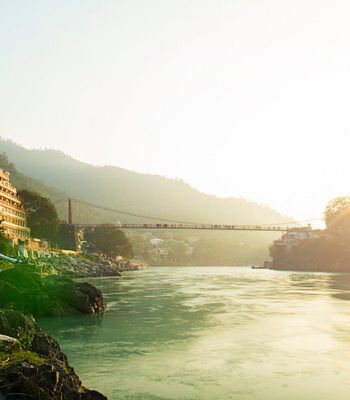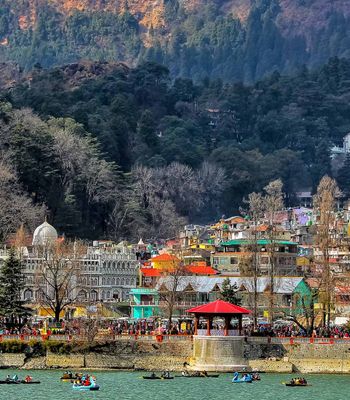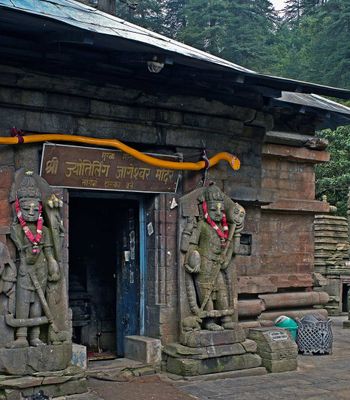High in the sacred foothills of Uttarakhand, where the holy Ganges first emerges from the mountains, stands the ancient city of Haridwar — a getaway to the divine. Overlooking the swirling waters and winding ghats, Chandi Devi Temple attracts many pilgrims with a promise of spirituality.
Perched majestically atop Neel Parvat at a height of 2,900 feet, this ancient shrine offers not just spiritual peace but also breathtaking panoramic views of the sacred Ganges and the city below. What truly distinguishes this temple is its unique status as one of the Siddha Peethas, where prayers are believed to be unfailingly answered by the divine presence of Goddess Chandi.
Unveiling the Divine: The Rich History of Chandi Devi Temple
The Chandi Devi Temple’s foundation dates back to the 8th century CE when the renowned philosopher-saint Adi Shankaracharya established it during his mission to revive Hinduism across India. According to historical records, Shankaracharya established a “Siddha Peeth” with a self-manifested (swayambhu) idol of the goddess at this site where Chandi was believed to have slain the demons Shumbha and Nishumbha.
Though spiritually established in the 8th century, the current stone structure with beautiful architecture was built in 1929 by Suchat Singh, the King of Kashmir. Throughout centuries, the temple has remained an important religious landmark in Haridwar’s sacred geography, forming part of the revered Panch Tirth pilgrimage circuit.
The Majestic Architecture of Chandi Devi Temple
The Chandi Devi Temple exemplifies the classic Nagara architectural style characteristic of North Indian temple design featuring a modest-sized shikhara that rises elegantly against the Himalayan backdrop.
Key architectural highlights include:
- Built predominantly from locally sourced stone, the temple’s exterior showcases intricately carved reliefs depicting scenes from Hindu mythology, particularly those glorifying Goddess Chandi’s triumph over evil forces.
- The sanctum sanctorum houses the swayambhu (self-manifested) idol surrounded by a circumambulatory path for the parikrama ritual.
- The temple compound includes several smaller shrines and a spacious courtyard paved with stone slabs.
Explore the Best of Chandi Devi Temple
The Chandi Devi Temple complex offers several notable attractions that combine spiritual significance with natural beauty:
- Main Sanctum: It houses the self-manifested idol of goddess Chandi, considered highly powerful and auspicious by devotees.
- Cable Car Journey: The “Udan Khatola” ropeway offers a thrilling aerial perspective of the landscape while transporting visitors to the temple.
- Parvati Kund: It is a sacred water tank near the temple where pilgrims perform ritual ablutions before offering prayers.
- Stone Carvings: The external walls feature detailed relief work depicting various forms of the goddesses and scenes from Hindu mythology.
- Sunset Point: There is a specially dedicated area where you can witness spectacular sunsets over the Ganges Valley.
Lesser-Known Facts About Chandi Devi Temple
Here are some lesser-known facts about Chandi Devi Temple:
- The idol of Goddess Chandi is believed to have been consecrated using sacred tantric rituals that imbue it with special power.
- Archaeological evidence suggests the hill hosted ancient worship sites even before Shankaracharya established the formal temple. Small artefacts dating back to the 5th century have been discovered nearby.
- During particular astronomical alignments, twice yearly, sunlight directly illuminates the main deity’s face for approximately 5-7 minutes at sunrise.
- The temple bells are crafted from a special alloy believed to produce vibrations that clear negative energies from the surroundings.
Best Time to Experience The Glory Of Chandi Devi Temple
The most favourable period to visit Chandi Devi temple is during the post-monsoon (September to November) and spring (February to April) months when temperatures remain pleasant (15-30°C), with clear skies offering spectacular views of the surrounding landscape. These months provide comfortable conditions for the cable car journey and the alternative trekking route.
The temple appears most magnificent in the early mornings when the first rays of sunlight illuminate the shrine and the Ganges valley below. Evenings around sunset offer equally dramatic views, with golden light bathing the temple complex.
The temple operates from 06:00 AM to 08:00 PM, and extended hours are implemented during major festivals like Navratri.
Traveling to Chandi Devi Temple: A Scenic Journey
Getting to Chandi Devi temple in Haridwar is a breeze, no matter how you travel. Here’s a quick guide to help you find the best route:
By Air
The nearest airport to Chandi Devi Temple is Jolly Grant Airport (DED) in Dehradun, about 40 kilometres away. You will find several domestic airlines that operate daily flights connecting Dehradun to major Indian cities like Delhi, Mumbai, and Bangalore.
Once you reach the airport, you can easily find taxis and pre-paid cab services to take you to Haridwar, which takes less than an hour.
By Train
Reaching Haridwar by train is perhaps the most convenient option for most travellers. Haridwar Railway Station is well-connected to major cities across India, with regular trains from Delhi, Mumbai, Kolkata, Chennai, and other metropolitan areas.
From the railway station, the Chandi Devi Temple base, where the cable car starts, is just 3.5 km away and can be reached by local transport in about 10 minutes.
By Road
Haridwar enjoys excellent road connectivity with well-maintained highways connecting it to major North Indian cities. From Delhi, you can take NE-3, covering approximately 223 km in 4 hours, depending on the traffic conditions.
Regular bus services run from Delhi’s ISBT Kashmere Gate to Haridwar, with options ranging from ordinary state transport buses to air-conditioned Volvo coaches. Buses also operate from nearby cities like Dehradun, Rishikesh, and Mussoorie.
A Navratri Experience Like No Other
Chandi Devi Temple comes alive during Navratri celebrations held twice a year - Chaitra Navratri and Sharad Navratri - when thousands of devotees undertake pilgrimages to seek the goddess’s blessings. During these 9-day festivals, the temple is adorned with beautiful floral decorations, and special rituals, including havan ceremonies and akhand path, are performed.
A visit to the Chandi Devi Temple offers more than just a spiritual journey; it’s an experience that combines breathtaking views, rich history and deep cultural significance. It doesn’t matter whether you’re visiting this temple for the divine atmosphere or seeking blessings; this sacred site promises to leave you with lasting memories.
